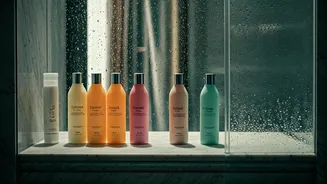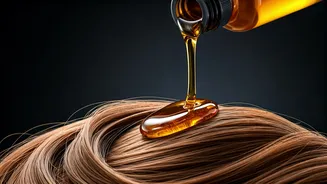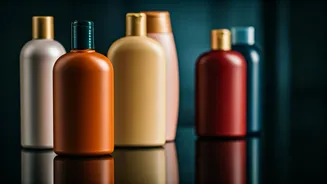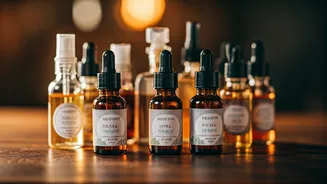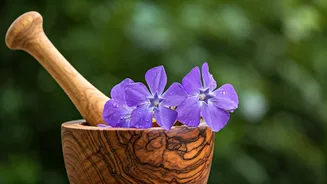Winter's Harsh Reality
Winter brings a dramatic shift in environmental conditions that significantly impacts hair health. The drop in temperature outside, combined with the dry
air generated by indoor heating systems, strips the hair of its natural moisture. This leads to increased dryness and roughness of the hair cuticle, making it prone to frizz. Furthermore, cold weather reduces the production of natural oils on the scalp, making the hair even more vulnerable. Consequently, hair becomes brittle, difficult to manage, and lacks its usual shine. Recognizing these challenges is the first step towards effectively addressing and mitigating the adverse effects of winter on your hair. This understanding will pave the way for adopting tailored hair care strategies.
Hydrate from Within
Boosting your water intake is fundamental for overall health, and it plays a critical role in maintaining well-hydrated hair. Drinking enough water supports your body's natural processes, including the production and distribution of sebum, the hair's natural oil. This natural oil moisturizes the scalp and hair strands, helping to prevent dryness. Additionally, a well-hydrated body promotes overall hair elasticity, making hair less susceptible to breakage and damage. Aim to drink the recommended daily amount of water, which varies based on individual factors such as activity level and body size, to ensure your hair receives adequate hydration from the inside out. Consider carrying a reusable water bottle and setting reminders to sip water regularly throughout the day, especially during the dry winter months. This proactive approach supports both overall health and optimal hair moisture levels.
Oil's Soothing Embrace
Incorporating hair oiling into your winter hair care routine offers deep nourishment and helps combat the dryness winter inflicts. Natural oils like coconut, almond, and argan oil are rich in fatty acids and vitamins that penetrate the hair shaft, restoring moisture and repairing damage. Coconut oil is particularly effective at reducing protein loss, strengthening hair from within. Almond oil can improve shine and manageability. Argan oil provides added conditioning and helps to tame frizz. Apply the oil gently, massaging it into the scalp and distributing it evenly through the hair. Leave the oil on for at least an hour, or overnight for deeper conditioning, before washing your hair. This practice forms a protective barrier, reducing moisture loss and leaving hair feeling soft, smooth, and revitalized.
Gentle Washing Wisdom
The way you wash your hair significantly impacts its health, especially during winter. Over-washing strips away natural oils, leading to dryness and frizz. Adjust your washing frequency, opting for fewer washes per week, depending on your hair type and activity level. When you do wash your hair, choose a sulfate-free shampoo. Sulfates are harsh detergents that can further strip away essential oils, exacerbating dryness. Look for shampoos containing moisturizing ingredients such as aloe vera, honey, or shea butter. These ingredients help retain moisture while cleaning the hair gently. Additionally, using lukewarm or cool water instead of hot water helps prevent the opening of the hair cuticle, which can lead to moisture loss. This practice helps to preserve your hair’s natural moisture barrier, crucial during the dry winter.
Masking for Maximum Moisture
Hair masks are an excellent way to provide intense hydration and nourishment, especially when facing the harsh winter conditions. Homemade or commercially available hair masks can penetrate deeply into the hair shaft, providing essential moisture and restoring its health. Ingredients such as honey, yogurt, avocado, and olive oil work to hydrate, strengthen, and smooth the hair. Honey is a natural humectant, meaning it attracts and retains moisture. Yogurt provides protein that strengthens hair follicles. Avocado is rich in fatty acids and vitamins that promote shine and manageability. Olive oil is a rich source of antioxidants. Apply a hair mask once or twice a week, allowing it to sit for at least 20-30 minutes, or longer for more intense conditioning. Regular use of hair masks can significantly improve your hair's overall health and appearance during winter.
Protective Styling Strategies
The way you style your hair can either protect it from or expose it to environmental damage during winter. Protective hairstyles, such as braids, buns, or twists, minimize direct exposure to harsh weather conditions and reduce the likelihood of friction and breakage. These styles keep the ends of your hair tucked away, which prevents moisture loss and protects against split ends. When using heat styling tools, always apply a heat protectant spray to minimize damage. These products create a protective barrier that reduces heat's impact. Use heat styling tools sparingly and opt for lower heat settings to prevent excessive dryness. Additionally, choosing silk or satin pillowcases is recommended. These materials create less friction than cotton, reducing breakage and tangling. By carefully selecting your styling methods and materials, you can significantly enhance your hair's resilience during the winter.


